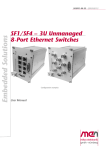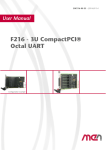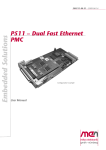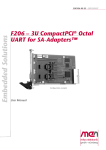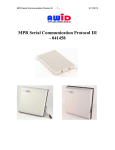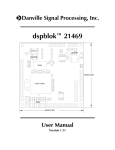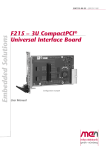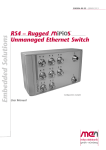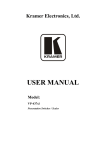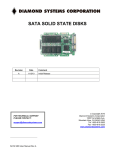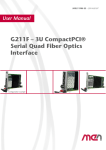Download 20P512-00 E2 User Manual
Transcript
20P512-00 E2 – 2013-11-11
User Manual
P512 – Reflective Memory
PMC
P512 - Reflective Memory PMC
P512 - Reflective Memory PMC
The P512 offers Reflective Memory functionality, for example for redundant
computer structures in safety-critical applications. Reflective memory is a memory
bus technology from Encore Computer that allows simultaneous reads and writes to
multiple memories. It can be used to share memory among multiple CPUs. The
advantage of reflective memory is the possibility to set up deterministic real-time
communication networks across computer systems and operating systems.
Each P512 module offers one LVDS channel. The modules can be interconnected in
a fully connected mesh and support multi-mode up to two meters. Each computer in
a system needs one PMC for each connection to another computer (2 computers: 1
PMC each, 3 computers: 2 PMCs each etc).
The module is equipped with 32 MB DDR2 DRAM.
The P512 is a PMC mezzanine card suitable for any PMC compliant host carrier
board in any type of bus system, i.e. CPCI, VME or on any type of stand-alone SBC
in telecommunication, industrial, medical, transportation or aerospace applications.
It supports 32 bits/33 MHz. Appropriate PMC carrier cards in 3U, 6U and other
formats are available from MEN or other manufacturers.
MEN Mikro Elektronik GmbH
20P512-00 E2 – 2013-11-11
2
Diagram
Diagram
Flash
2 MB
Configuration CPLD
FPGA
LVDS Receiver
50‐pin Front Connector
PCI
LVDS Interface
32‐bit /
33‐MHz
LVDS Transmitter
DDR2
SDRAM
32 MB
MEN Mikro Elektronik GmbH
20P512-00 E2 – 2013-11-11
3
Technical Data
Technical Data
Reflective memory
•
•
•
•
1 LVDS channel
Usable in fully connected mesh
Multi-mode up to 2 meters
Connection speed 230 MHz
- PCI to LVDS TX write performance (burst): 28.52 MB/s
- PCI to LVDS TX write performance (longword single): 15.89 MB/s
- DMA from PCI to LVDS TX performance (burst): 20.81 MB/s
Memory
• 32MB SDRAM memory
- Soldered
- DDR2
- 132MHz memory bus frequency
- FPGA-controlled
• 2MB non-volatile Flash
- For FPGA data
- FPGA-controlled
• Access to LVDS RX/TX memory
- PCI to RX/TX memory write performance (burst): 107.43 MB/s
- PCI to RX/TX memory read performance (burst): 99.16 MB/s
- PCI to RX/TX memory write performance (longword): 15.89 MB/s
- PCI to RX/TX memory read performance (longword): 5.37 MB/s
PMC Characteristics (PCI)
• Compliant with PCI Specification 2.2
• 32-bit/33-MHz, 3.3V V(I/O)
• Target
Peripheral Connections
• Via front panel on a shielded 50-pin HP D-Sub SCSI 2 receptacle connector
Electrical Specifications
• Supply voltage/power consumption:
- +5V (-3%/+5%), 109mA
- +3.3V (-5%/+5%), 143mA
Mechanical Specifications
• Dimensions: conforming to IEEE 1386.1
• Weight: 78g
MEN Mikro Elektronik GmbH
20P512-00 E2 – 2013-11-11
4
Technical Data
Environmental Specifications
• Temperature range (operation):
- -40..+85°C (qualified components)
- Airflow: min. 1.0m/s
• Temperature range (storage): -40..+85°C
• Relative humidity (operation): max. 95% non-condensing
• Relative humidity (storage): max. 95% non-condensing
• Altitude: -300m to + 3,000m
• Shock: 15g/11ms
• Bump: 10g/16ms
• Vibration (sinusoidal): 1g/10..150Hz
• Conformal coating on request
MTBF
• 1 434 674 h @ 40°C according to IEC/TR 62380 (RDF 2000)
Safety
• PCB manufactured with a flammability rating of 94V-0 by UL recognized manufacturers
EMC
• Conforming to EN 55022 (radio disturbance), IEC1000-4-2 (ESD) and
IEC1000-4-4 (burst)
Software Support
• MDIS™ driver
MEN Mikro Elektronik GmbH
20P512-00 E2 – 2013-11-11
5
Product Safety
Product Safety
!
Electrostatic Discharge (ESD)
Computer boards and components contain electrostatic sensitive devices.
Electrostatic discharge (ESD) can damage components. To protect the board and
other components against damage from static electricity, you should follow some
precautions whenever you work on your computer.
• Power down and unplug your computer system when working on the inside.
• Hold components by the edges and try not to touch the IC chips, leads, or circuitry.
• Use a grounded wrist strap before handling computer components.
• Place components on a grounded antistatic pad or on the bag that came with the
component whenever the components are separated from the system.
• Store the board only in its original ESD-protected packaging. Retain the original
packaging in case you need to return the board to MEN for repair.
MEN Mikro Elektronik GmbH
20P512-00 E2 – 2013-11-11
6
About this Document
About this Document
This user manual is intended only for system developers and integrators, it is not
intended for end users.
It describes the hardware functions of the board, connection of peripheral devices
and integration into a system. It also provides additional information for special
applications and configurations of the board.
The manual does not include detailed information on individual components (data
sheets etc.). A list of literature is given in the appendix.
History
Issue
Comments
Date of Issue
E1
First issue
2009-07-01
E2
Added memory speeds in the Technical Data, corrected Table 3, Adapter cable wiring, on page 15
2013-11-11
Conventions
!
italics
bold
monospace
This sign marks important notes or warnings concerning proper functionality of the
product described in this document. You should read them in any case.
Folder, file and function names are printed in italics.
Bold type is used for emphasis.
A monospaced font type is used for hexadecimal numbers, listings, C function
descriptions or wherever appropriate. Hexadecimal numbers are preceded by "0x".
comment
Comments embedded into coding examples are shown in green color.
hyperlink
Hyperlinks are printed in blue color.
The globe will show you where hyperlinks lead directly to the Internet, so you can
look for the latest information online.
IRQ#
/IRQ
Signal names followed by "#" or preceded by a slash ("/") indicate that this signal is
either active low or that it becomes active at a falling edge.
in/out
Signal directions in signal mnemonics tables generally refer to the corresponding
board or component, "in" meaning "to the board or component", "out" meaning
"coming from it".
Vertical lines on the outer margin signal technical changes to the previous issue of
the document.
MEN Mikro Elektronik GmbH
20P512-00 E2 – 2013-11-11
7
About this Document
Legal Information
Changes
MEN Mikro Elektronik GmbH ("MEN") reserves the right to make changes without further notice to any products
herein.
Warranty, Guarantee, Liability
MEN makes no warranty, representation or guarantee of any kind regarding the suitability of its products for any
particular purpose, nor does MEN assume any liability arising out of the application or use of any product or
circuit, and specifically disclaims any and all liability, including, without limitation, consequential or incidental
damages. TO THE EXTENT APPLICABLE, SPECIFICALLY EXCLUDED ARE ANY IMPLIED
WARRANTIES ARISING BY OPERATION OF LAW, CUSTOM OR USAGE, INCLUDING WITHOUT
LIMITATION, THE IMPLIED WARRANTIES OF MERCHANTABILITY AND FITNESS FOR A
PARTICULAR PURPOSE OR USE. In no event shall MEN be liable for more than the contract price for the
products in question. If buyer does not notify MEN in writing within the foregoing warranty period, MEN shall
have no liability or obligation to buyer hereunder.
The publication is provided on the terms and understanding that:
1. MEN is not responsible for the results of any actions taken on the basis of information in the publication, nor
for any error in or omission from the publication; and
2. MEN is not engaged in rendering technical or other advice or services.
MEN expressly disclaims all and any liability and responsibility to any person, whether a reader of the publication
or not, in respect of anything, and of the consequences of anything, done or omitted to be done by any such person
in reliance, whether wholly or partially, on the whole or any part of the contents of the publication.
Conditions for Use, Field of Application
The correct function of MEN products in mission-critical and life-critical applications is limited to the
environmental specification given for each product in the technical user manual. The correct function of MEN
products under extended environmental conditions is limited to the individual requirement specification and
subsequent validation documents for each product for the applicable use case and has to be agreed upon in writing
by MEN and the customer. Should the customer purchase or use MEN products for any unintended or
unauthorized application, the customer shall indemnify and hold MEN and its officers, employees, subsidiaries,
affiliates, and distributors harmless against all claims, costs, damages, and expenses, and reasonable attorney fees
arising out of, directly or indirectly, any claim or personal injury or death associated with such unintended or
unauthorized use, even if such claim alleges that MEN was negligent regarding the design or manufacture of the
part. In no case is MEN liable for the correct function of the technical installation where MEN products are a part
of.
Trademarks
All products or services mentioned in this publication are identified by the trademarks, service marks, or product
names as designated by the companies which market those products. The trademarks and registered trademarks
are held by the companies producing them. Inquiries concerning such trademarks should be made directly to those
companies.
Conformity
MEN products are no ready-made products for end users. They are tested according to the standards given in the
Technical Data and thus enable you to achieve certification of the product according to the standards applicable in
your field of application.
MEN Mikro Elektronik GmbH
20P512-00 E2 – 2013-11-11
8
About this Document
RoHS
Since July 1, 2006 all MEN standard products comply with RoHS legislation.
Since January 2005 the SMD and manual soldering processes at MEN have already been completely lead-free.
Between June 2004 and June 30, 2006 MEN’s selected component suppliers have changed delivery to RoHScompliant parts. During this period any change and status was traceable through the MEN ERP system and the
boards gradually became RoHS-compliant.
WEEE Application
The WEEE directive does not apply to fixed industrial plants and tools. The compliance is the responsibility of the
company which puts the product on the market, as defined in the directive; components and sub-assemblies are
not subject to product compliance.
In other words: Since MEN does not deliver ready-made products to end users, the WEEE directive is not
applicable for MEN. Users are nevertheless recommended to properly recycle all electronic boards which have
passed their life cycle.
Nevertheless, MEN is registered as a manufacturer in Germany. The registration number can be provided on
request.
Copyright © 2013 MEN Mikro Elektronik GmbH. All rights reserved.
Germany
MEN Mikro Elektronik GmbH
Neuwieder Straße 3-7
90411 Nuremberg
Phone +49-911-99 33 5-0
Fax +49-911-99 33 5-901
E-mail [email protected]
www.men.de
MEN Mikro Elektronik GmbH
20P512-00 E2 – 2013-11-11
France
MEN Mikro Elektronik SA
18, rue René Cassin
ZA de la Châtelaine
74240 Gaillard
Phone +33 (0) 450-955-312
Fax +33 (0) 450-955-211
E-mail [email protected]
www.men-france.fr
USA
MEN Micro Inc.
860 Penllyn Blue Bell Pike
Blue Bell, PA 19422
Phone (215) 542-9575
Fax (215) 542-9577
E-mail [email protected]
www.menmicro.com
9
Contents
Contents
1 Getting Started . . . . . . . . . . . . . . . . . . . . . . . . . . . . . . . . . . . . . . . . . . . . . . . .
1.1 Map of the Board. . . . . . . . . . . . . . . . . . . . . . . . . . . . . . . . . . . . . . . . .
1.2 Integrating the Board into a System . . . . . . . . . . . . . . . . . . . . . . . . . .
1.3 Installing Driver Software . . . . . . . . . . . . . . . . . . . . . . . . . . . . . . . . . .
13
13
13
13
2 Connecting the PMC Module . . . . . . . . . . . . . . . . . . . . . . . . . . . . . . . . . . . .
2.1 Peripheral Interfaces . . . . . . . . . . . . . . . . . . . . . . . . . . . . . . . . . . . . . .
2.2 Connecting two P512 PMCs . . . . . . . . . . . . . . . . . . . . . . . . . . . . . . . .
2.3 Host PCI Interface . . . . . . . . . . . . . . . . . . . . . . . . . . . . . . . . . . . . . . . .
14
14
15
17
3 Functional Description . . . . . . . . . . . . . . . . . . . . . . . . . . . . . . . . . . . . . . . . . .
3.1 Power Supply. . . . . . . . . . . . . . . . . . . . . . . . . . . . . . . . . . . . . . . . . . . .
3.2 LVDS . . . . . . . . . . . . . . . . . . . . . . . . . . . . . . . . . . . . . . . . . . . . . . . . . .
3.2.1
LEDs . . . . . . . . . . . . . . . . . . . . . . . . . . . . . . . . . . . . . . . . . . .
19
19
19
20
4 Appendix . . . . . . . . . . . . . . . . . . . . . . . . . . . . . . . . . . . . . . . . . . . . . . . . . . . . . 21
4.1 PCI Configuration . . . . . . . . . . . . . . . . . . . . . . . . . . . . . . . . . . . . . . . . 21
4.2 Literature and Web Resources . . . . . . . . . . . . . . . . . . . . . . . . . . . . . . . 21
4.3 Finding out the Board’s Article Number, Revision and Serial Number21
MEN Mikro Elektronik GmbH
20P512-00 E2 – 2013-11-11
10
Figures
Figure 1.
Figure 2.
Figure 3.
Figure 4.
Figure 5.
MEN Mikro Elektronik GmbH
20P512-00 E2 – 2013-11-11
Map of the board – top view. . . . . . . . . . . . . . . . . . . . . . . . . . . . . . . . .
Cable for connecting two P512 modules . . . . . . . . . . . . . . . . . . . . . . .
P512 memory sections . . . . . . . . . . . . . . . . . . . . . . . . . . . . . . . . . . . . .
Position of status LEDs at front of P512 . . . . . . . . . . . . . . . . . . . . . . .
Label giving the board’s article number, revision and serial number .
13
15
19
20
21
11
Tables
Table 1.
Table 2.
Table 3.
Table 4.
Table 5.
Table 6.
MEN Mikro Elektronik GmbH
20P512-00 E2 – 2013-11-11
Pin assignment of 50-pin HP D-Sub front connector . . . . . . . . . . . . . .
Signal mnemonics of 50-pin front connector . . . . . . . . . . . . . . . . . . . .
Adapter cable wiring . . . . . . . . . . . . . . . . . . . . . . . . . . . . . . . . . . . . . .
Pin assignment of 64-pin board-to-board connector Pn1 . . . . . . . . . . .
Pin assignment of 64-pin board-to-board connector Pn2 . . . . . . . . . . .
Status LEDs . . . . . . . . . . . . . . . . . . . . . . . . . . . . . . . . . . . . . . . . . . . . .
14
15
15
17
18
20
12
Getting Started
1
Getting Started
This chapter gives an overview of the board and some hints for first installation in a
system.
1.1
Map of the Board
Figure 1. Map of the board – top view
8
7 6 5
LEDs 8..5
FPGA
PCI bus
connectors
Pn1
Pn2
50-pin
HP D-Sub
SCSI 2
connector
LEDs 4..1
4
3 2 1
1.2
Integrating the Board into a System
You can use the following "check list" to install the PMC on a carrier board for the
first time and to test proper functioning of the board.
Power-down the system and remove the PMC carrier board.
Install the PMC in a suitable front-panel slot of the carrier board as described in
the carrier board’s user manual.
Insert the carrier board into the system again.
Power-up the system.
If there is a system crash or other abnormal behavior at start-up, check if the
PMC is plugged properly.
You can now install driver software for the P512.
1.3
Installing Driver Software
For a detailed description on how to install driver software please refer to the
respective documentation.
You can find any driver software available for download on MEN’s website.
MEN Mikro Elektronik GmbH
20P512-00 E2 – 2013-11-11
13
Connecting the PMC Module
2
Connecting the PMC Module
2.1
Peripheral Interfaces
Peripherals can only be connected via the 50-pin half-pitch D-Sub connector.
Connector types:
• 50-pin half-pitch D-Sub receptacle with latch block, 1.27 mm pitch
• Mating connector:
50-pin half-pitch D-Sub plug with latch, 1.27 mm pitch
Table 1. Pin assignment of 50-pin HP D-Sub front connector
1
25
MEN Mikro Elektronik GmbH
20P512-00 E2 – 2013-11-11
26
50
1
TX0[0]+
26
TX0[0]-
2
TX0[1]+
27
TX0[1]-
3
TX0[2]+
28
TX0[2]-
4
TX0_CLK+
29
TX0_CLK-
5
GND
30
GND
6
GND
31
GND
7
RX0[0]+
32
RX0[0]-
8
RX0[1]+
33
RX0[1]-
9
RX0[2]+
34
RX0[2]-
10
RX0_CLK+
35
RX0_CLK-
11
GND
36
GND
12
GND
37
GND
13
-
38
-
14
-
39
-
15
-
40
-
16
-
41
-
17
-
42
-
18
-
43
-
19
-
44
-
20
-
45
-
21
-
46
-
22
-
47
-
23
-
48
-
24
-
49
-
25
-
50
-
14
Connecting the PMC Module
Table 2. Signal mnemonics of 50-pin front connector
Signal
Direction
Function
GND
-
Ground
RX0[0..2]+/-
in
LVDS receive lines, channel 0
TX0[0..2]+/-
out
LVDS transmit lines, channel 0
2.2
Connecting two P512 PMCs
MEN offers a crossed TX-to-RX and RX-to-TX cable for connecting two P512
modules.
For ordering information see MEN’s website.
The cable is wired in the following way:
Figure 2. Cable for connecting two P512 modules
Table 3. Adapter cable wiring
Side B
Pin 1
Pin 7
Pin 2
Pin 8
Pin 3
Pin 9
Pin 4
Pin 10
Pin 5
Pin 5
Pin 6
not connected
Pin 7
Pin 1
Pin 8
Pin 2
Pin 9
Pin 3
Pin 10
Pin 4
Pin 11 - Pin 25
not connected
Pin 26
Pin 32
Pin 27
Pin 33
Pin 28
Pin 34
Pin 29
Pin 35
Pin 30
Pin 30
MEN Mikro Elektronik GmbH
20P512-00 E2 – 2013-11-11
Side A
15
Connecting the PMC Module
Side B
Pin 31
not connected
Pin 32
Pin 26
Pin 33
Pin 27
Pin 34
Pin 28
Pin 35
Pin 29
Pin 36 - 50
not connected
MEN Mikro Elektronik GmbH
20P512-00 E2 – 2013-11-11
Side A
16
Connecting the PMC Module
2.3
Host PCI Interface
The P512 PMC supports the following signals of the 64-pin carrier board interface
connectors:
Table 4. Pin assignment of 64-pin board-to-board connector Pn1
2
64
MEN Mikro Elektronik GmbH
20P512-00 E2 – 2013-11-11
1
63
1
-
2
-
3
GND
4
INTA#
5
-
6
-
7
-
8
+5V
9
INTD_R#
10
-
11
GND
12
-
13
CLK[0]
14
GND
15
GND
16
GNT[0]#
17
REQ[0]#
18
+5V
19
-
20
AD[31]
21
AD[28]
22
AD[27]
23
AD[25]
24
GND
25
GND
26
C/BE[3]#
27
AD[22]
28
AD[21]
29
AD[19]
30
+5V
31
V_IO
32
AD[17]
33
FRAME#
34
GND
35
GND
36
IRDY#
37
DEVSEL#
38
+5V
39
GND
40
-
41
-
42
-
43
PAR
44
GND
45
-
46
AD[15]
47
AD[12]
48
AD[11]
49
AD[9]
50
+5V
51
GND
52
C/BE[0]#
53
AD[6]
54
AD[5]
55
AD[4]
56
GND
57
-
58
AD[3]
59
AD[2]
60
AD[1]
61
AD[0]
62
+5V
63
GND
64
-
17
Connecting the PMC Module
Table 5. Pin assignment of 64-pin board-to-board connector Pn2
2
64
1
63
1
-
2
-
3
-
4
-
5
-
6
GND
7
GND
8
-
9
-
10
-
11
-
12
+3.3V
13
RST#
14
-
15
+3.3V
16
-
17
PME_R#
18
GND
19
AD[30]
20
AD[29]
21
GND
22
AD[26]
23
AD[24]
24
+3.3V
25
IDSEL[0]
26
AD[23]
27
+3.3V
28
AD[20]
29
AD[18]
30
GND
31
AD[16]
32
C/BE[2]#
33
GND
34
-
35
TRDY#
36
+3.3V
37
GND
38
STOP#
39
PERR#
40
GND
41
+3.3V
42
SERR#
43
C/BE[1]#
44
GND
45
AD[14]
46
AD[13]
47
-
48
AD[10]
49
AD[8]
50
+3.3V
51
AD[7]
52
-
53
+3.3V
54
-
55
-
56
GND
57
-
58
-
59
GND
60
-
61
-
62
+3.3V
63
GND
64
-
Connector types of Pn1 and Pn2:
• 64-pin SMT plug connector according to IEEE P1386
• Mating connector:
64-pin SMT receptacle connector according to IEEE P1386
MEN Mikro Elektronik GmbH
20P512-00 E2 – 2013-11-11
18
Functional Description
3
Functional Description
3.1
Power Supply
Power supply to the logic part is done via the carrier board (connectors Pn1/Pn2).
The necessary voltages are +5V and +3.3V.
3.2
LVDS
The P512 uses a high speed LVDS connection for exchanging memory content
between several computer units. One LVDS channel, i.e. one LVDS transmit path
and one LVDS receive path is accessible at the front connector.
The transmitted and received data are stored in a 32 MB soldered DDR2 SDRAM
memory, which is controlled by an FPGA. The memory bus frequency is 132 MHz.
The DDR2 SDRAM memory is divided into two 16 MB memory sections. The
sections are writable and readable via PCI write/read access and are named
Transmit Memory Section and Receive Memory Section.
LVDS Data Transmission
Data written to the Transmit Memory Section is stored in the local DDR2 SDRAM
and at the same time the written data is also transmitted via LVDS if the LVDS
transmitter is enabled.
LVDS Data Reception
There are two different types of LVDS packets which contain user-defined data.
These packets are write data packets and control packets. Write data packets contain
information which is stored in the DDR2 SDRAM. This means, if the receiver is
enabled and a LVDS write data packet is received, the data is stored in the local
DDR2 SDRAM Receive Memory Section.
Example: If the 16-bit data packet 0xABCD is written to offset address 0x104 of the
Transmit Memory Section of the transmitting P512, a write data packet is
transmitted which contains the data (0xABCD) and the address (0x104). The
receiving P512 will evaluate this write data packet and write the received data
(0xABCD) to its Receive Memory Section at offset address 0x104.
Figure 3. P512 memory sections
P512
16 MB
TX Memory Section
Mapped to PCI
BAR 1
TX
P512
DDR2
SDRAM
TX
RX
RX
16 MB
RX Memory Section
Mapped to PCI
BAR 2
TX
DDR2
SDRAM
RX
TX
RX
LVDS
MEN Mikro Elektronik GmbH
20P512-00 E2 – 2013-11-11
19
Functional Description
3.2.1
LEDs
There are eight status LEDs at the front panel of the P512.
LED 1 lights up as soon as the FPGA was configured. LED 5, 6, 7 and 8 show the
status of the LVDS connection.
LEDs 2, 3 and 4 are controlled through a GPIO controller inside the FPGA and are
software-configurable. Please contact MEN’s sales team for further information.
For a detailed description of the function of each LED see Figure 4, Position of
status LEDs at front of P512 on page 20 and Table 6, Status LEDs on page 20.
Figure 4. Position of status LEDs at front of P512
8
7 6 5
LEDs 8..5
50-pin
HP D-Sub
SCSI 2
connector
LEDs 4..1
4
3 2 1
Table 6. Status LEDs
LED
Function
1
Green
FPGA is configured
2
Yellow
Software-configurable LEDs
3
Red
4
Green
5
Green
LVDS receiver active
6
Yellow
LVDS connection
7
Red
LVDS data lost
8
Green
LVDS transmitter active
MEN Mikro Elektronik GmbH
20P512-00 E2 – 2013-11-11
Color
20
Appendix
4
Appendix
4.1
PCI Configuration
The P512 has the following IDs on the PCI bus:
•
•
•
•
PCI Device ID: 0x4D45
PCI Vendor ID: 0x1A88
Subsystem Device ID: 0x5A14
Subsystem Vendor ID: 0x0087
4.2
Literature and Web Resources
• P512 data sheet with up-to-date information and documentation:
www.men.de/products/15P512-.html
4.3
Finding out the Board’s Article Number, Revision and
Serial Number
MEN user documentation may describe several different models and/or hardware
revisions of the P512. You can find information on the article number, the board
revision and the serial number on two labels attached to the board.
• Article number: Gives the board’s family and model. This is also MEN’s ordering number. To be complete it must have 9 characters.
• Revision number: Gives the hardware revision of the board.
• Serial number: Unique identification assigned during production.
If you need support, you should communicate these numbers to MEN.
Figure 5. Label giving the board’s article number, revision and serial number
Complete article number
Article No.:
15P512-00
Serial No.:
000001
Rev. 00.00.00
Serial number
Revision number
MEN Mikro Elektronik GmbH
20P512-00 E2 – 2013-11-11
21





















